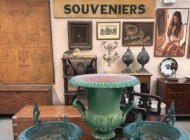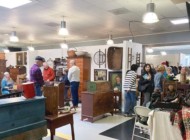
It was a perfect fall day at the Dutchess County Fairgrounds, where Antiques at Rhinebeck’s Fall Show was in full swing immediately after opening on October 8.
Review & Photos by Z.G. Burnett
RHINEBECK, N.Y. – The sun was shining on Dutchess County Fairgrounds October 8-9, portending a successful weekend for Antiques at Rhinebeck’s Fall Show, organized and promoted by Frank Gaglio and Barn Star Productions, a company he began in 1994 with the goal of providing premier antique shows and events. “This is one of the best shows we’ve ever had,” said Gaglio on the first day. “Sales are through the roof, and we’ve seen a great increase in attendance, especially with young families.” By the end of the weekend, these numbers would be record-breaking for the show. Two six-passenger golf carts were used to great effect for these guests and veteran collectors, who appreciated the transportation from the parking lot to the venue. Gaglio expressed his intention of making Antiques at Rhinebeck “a fun fall family event,” and the show was especially successful in this regard.
Any category a collector could want was in ready supply at Rhinebeck, and it was a credit to the Barn Star team that they all fit cohesively under one roof. Barn Star provided a much-needed map of dealers. Divided into three buildings, the rows of booths were well-populated, often creating traffic jams as the first rush of customers inspected, bought and tried to remove their purchases without incident. Sold tags sprouted up like mushrooms, and each dealer with whom we spoke was already having a great show by midmorning. “The pressure’s off,” said Joseph Collins of Middletown, Conn., who by 10 am had already done “decently.”
Mystery objects are frequently found at antiques shows, and some collectors even seek them out. This was the case with a large industrial contraption brought by Dennis and Valerie Bakoledis of Rhinebeck, N.Y., which formed the centerpiece of their booth. Resembling a Christmas tree, the object was made from a wooden post with bent metal bars helixing around it. Dennis knew by its construction that the object was made in the Nineteenth Century and postulated that it may have been used for air circulation. Whatever it was, the sculptural piece had already sold by 10 am and was just waiting to be picked up.
On a smaller scale, sample furniture was plentiful at more than a few booths, but few were as charming as an early Nineteenth Century example presented by Jacqueline Walker Antiques of Aberdeen, Md., who only recently discovered the diminutive dresser. It retained all of its original paint and hardware, sporting handmade nails with only minor damage to some of its joints that could easily be repaired. The black-painted surface was carefully detailed by hand, with gold borders surrounding floral boughs on the drawers’ front boards. Walker offered the dresser for $725.
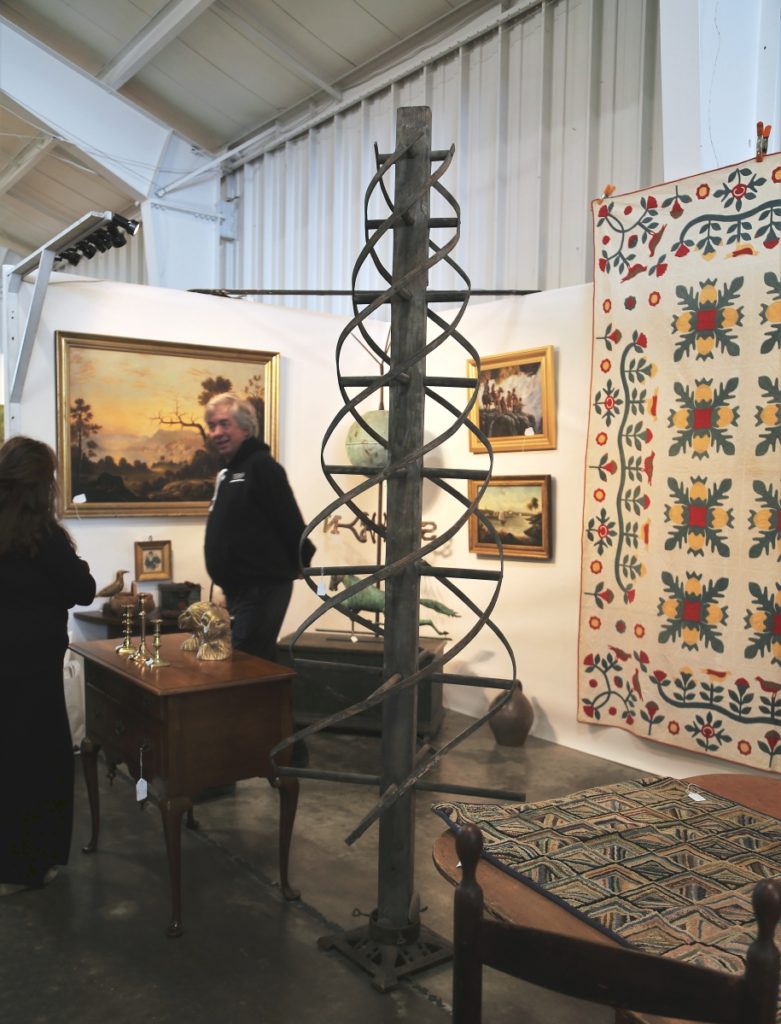
What’s an antiques show without a whatsit? Dennis Bakoledis, Rhinebeck, N.Y., only knew that this contraption was from the Nineteenth Century, that it presented very well and had already sold early in the show.
There was no minute number of miniatures available either, if you were fast enough. Adam Irish of Old As Adam in Providence, R.I., showcased a ready-made dollhouse that he believed to be fashioned from a shipping crate. Its interiors were painstakingly pasted onto the boards and appeared to have been well-loved. Irish showed that the exterior has also been decorated with windows to the dollhouse’s four “floors.” This was one of his many sold items by midmorning.
Bob Ketelhut of Oakland Art & Antiques, West Bloomfield, Mich., was selling his own handiwork in a booth shared with his son’s business, Bradbury Art & Antiques of Edgecomb, Maine. Ketelhut mounted a collection of tennis balls that had long lost their fuzz in an antique clock case; they were fished out of a pond by Ketelhut’s friend, who was more than happy to pass them off. The assemblage was priced at $550.
The booth of Jewett-Berdan Antiques of Newcastle, Maine, was prepared for Halloween, with vintage decorations and an Odd Fellows’ skeleton banner on their outer wall and an antique, unsigned carnival banner as their showpiece. Advertising the services of a palm reader, it read, “Everyone is wiser and happier after consulting her.” The banner also advised, “Knowledge is power. Seek it before it is too late.” It was “a real nice piece,” according to Charles “Butch” Berdan, who dated the rare and exceptionally preserved banner to the 1920s or 1930s and was asking $3,850.
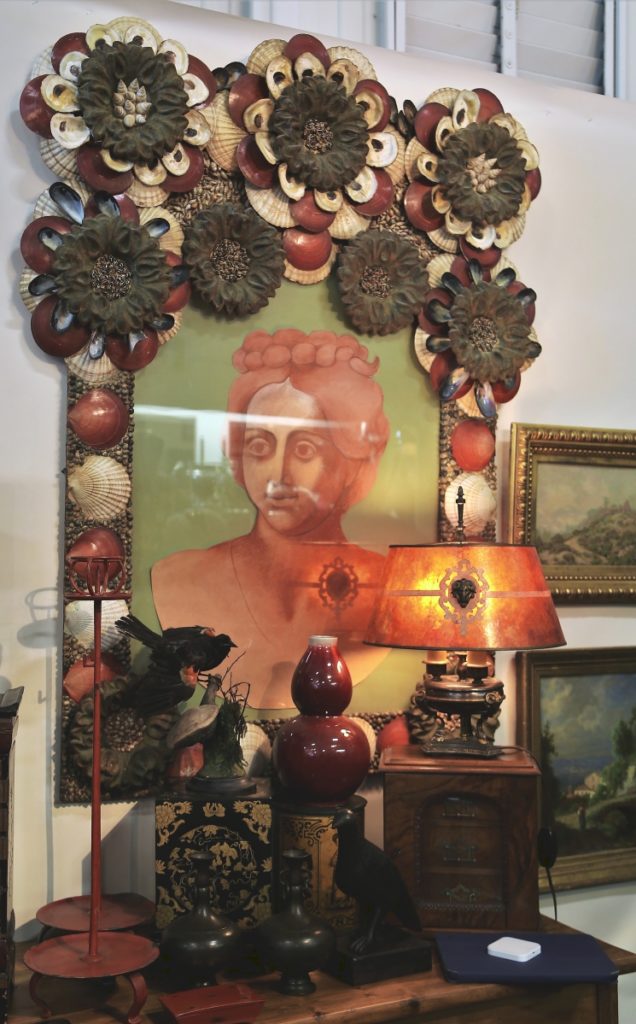
More & More Antiques, New York City, asked $2,800 for this monumental shellwork frame and cutout sketch.
Along with banners, vintage and antique flags were a hot-ticket item at Rhinebeck, and no booth could rival those shown at the Public Sale auction house’s outpost. An entire personal collection of Asafo flags completely covered the booth’s walls but were not yet for sale; they are scheduled for auction on January 7. Asafo flags show regimental emblems of the Fante people’s warrior groups in Akan culture and combine the visual traditions of European heraldry with regional proverbs. Asafo is a combination of the words sa meaning “war” and fo meaning “people,” and were produced partly as regalia in Fante conflict with the Ashanti people. Both of these ethnic groups reside in the central and western coastal regions of Ghana, and their imagery is typically concerned with proverbs about security and warfare. Oliver Garland (Falmouth, Mass., and London, England) was also offering a larger, mounted Asafo flag on the exterior of his booth with images from the fable of “The Pepper Tree” for $1,200.
Nearby this display was the booth of Bettina Krainin Antiques of Woodbury, Conn., offering so many treasures per square foot that it was difficult to decide which to feature. The central display first caught our attention, including a mounted teepee fragment and two horse weathervanes. The fragment was from New Mexico, circa 1880-1910, and decorated with a reindeer and a buffalo hunting party, watched over by the rising sun. It was priced at $8,000. Below were two figural horse weathervanes, positioned as though they were facing off. The horse on the left was a circa 1860 A.L. Jewell weathervane, with a full copper body and a zinc head. The tail was fully cut with gold gilt, and it was marked at $22,000. On the right was a horse weathervane from the Howard Company, also circa 1860, with a gilt half-zinc and half-copper body and an extremely rare cut mane and tail. This horse was priced at $32,000.
Less storied but no less appealing was a folk art statue on its own pedestal from the Nexus Similarity, offered by Aarne Anton. Found in South Carolina, the well-weathered statue of a guardian animal, either a cat or dog, was signed “Granforte” on its base. “I thought it had [a William] Edmonson feeling, but no,” Anton commented. Made from local stone, he believed that the statue was early Twentieth Century and was asking $4,500.
Trade figurines are another requisite category at antiques shows, and the smallest example was found in the booth of Francis Crespo of Lancaster, Penn. Unlike the more common large wood cigar store figures, Crespo’s was made from rubber, a less expensive alternative for shop owners who could not afford a wood trade figure. Crespo dated the figure circa 1900-25 due to the applied plaster on the underside of the base, which would prevent the rubber statue from falling over. It was unmarked, retained its original surface and was offered at $475.
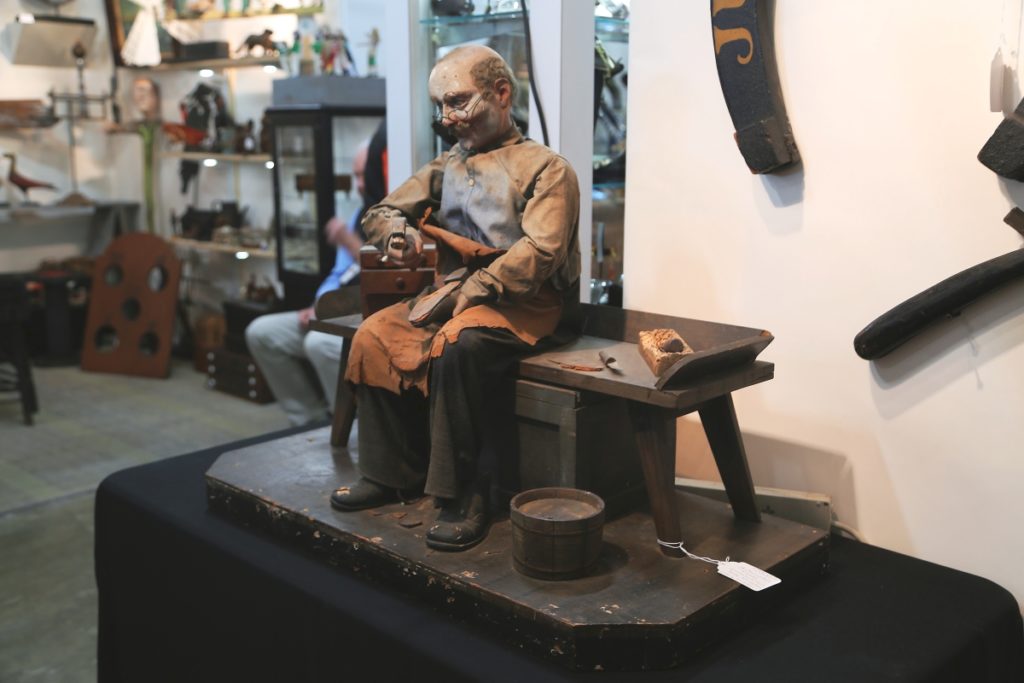
This Twentieth Century cobbler automaton was hard at work in the booth of Robert Conrad Antiques, Yeagertown, Penn., asking $2,000 for his services.
Fine art was also prevalent at the show, but few pieces combined the genres of portraiture, pet portraiture and landscape painting like the large-scale canvas hanging in the booth of J. Hamilton Howard. The painting shows an older man leading a pony ridden by a little boy, most likely his heir. The group is accompanied by three dogs: one hound and two terriers. Both are dressed in traditional Scottish garb, and the young rider has “the perfect ‘Little Charlie; The Prize Boy’ face.” Hamilton continued, “It’s a fully Scottish portrait, set against an all-Hudson background.” He bought the painting at a summer Brimfield show, after its original buyer was unable to fit it in their car. Hamilton offered the canvas without a frame for $2,500.
Another unusual portrait headlined in the booth of Maggie Milgrim Art & Antiques of Rhinebeck, N.Y., an oil on board likeness of pugilist Jago Weir in 1857. Not to be confused with the Featherweight champion Ike Weir (British American, 1867-1908), the boxer represented here was an earlier fighter and probably a weight class or so above the more famous Weir. Prizefighting was an established European tradition when this portrait was painted, and the London Prize Ring Rules were fully in effect. The Marquess of Queensbury rules would not be introduced until 10 years later. This was the first time Milgrim presented the portrait, believed to be American, British or possibly German, and was asking $1,800.
The cultural exchange of “New” and “Old” worlds was especially evident at the booth of G. Sergeant Antiques of Woodbury, Conn., where a striking Eighteenth Century games table stood proudly at the space’s corner panel. Masterfully wrought with bookplate marquetry in locust wood, the George II card table was documented and presented with a catalog from the Sotheby’s London 3 July 2003 Important English Furniture sale, where the table was sold. Black locust wood is native to the eastern United States, particularly in the Appalachian Mountain range. Locust is a dense, weather-resistant hard wood, and examples of furniture such as this are scarce. Sergeant mentioned that the wood was often used for concertinas and offered the table for $9,500.
Another uncommon use of materials was exhibited by More & More Antiques of New York City in a monumental shellwork frame. Made with sizeable scallop shells in different varieties, oyster shells and pressed tin discs cushioned by moon snail shells to cover any negative space, the frame was the largest piece of shellwork at the show. Proprietor Steve Mohr found the frame in the apartment of a New York City artist, where it had hung for 50 or 60 years. Mohr believed that the cutout in the frame was the former owner’s work and priced it together with the frame at $2,800.
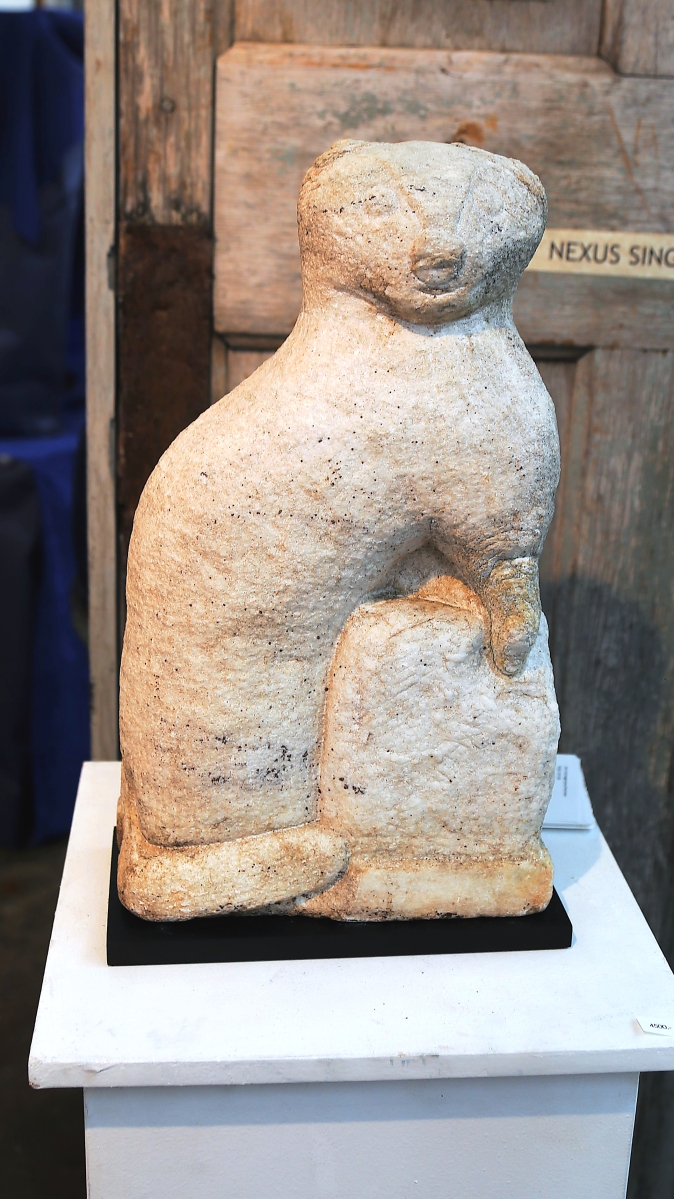
This folk art guardian creature was found on an estate in South Carolina and was offered by Nexus Singularity, Pomona, N.Y., for $4,500.
Chris and Karen Doscher of Witt’s End Antiques, Wallkill, N.Y., displayed a different kind of shellwork in their booth with a hooked rug in a geometric shell pattern. “It’s either late Nineteenth or early Twentieth Century, but it almost looks contemporary,” Chris said. The Doschers found the rug “on the Cape,” and it was in excellent condition, priced at $875.
Antiques at Rhinebeck’s Fall Show was dedicated to Antiques and The Arts Weekly’s late founder and publisher, R. Scudder Smith. “Needless to say,” Gaglio commented later, “Scudder’s spirit was with us all.” There was a noticeable number of parents at the show fostering interest in their children, the next generation of collectors. One father was heard saying to his small daughter in hand, “We buy the old things to give them a new life.” A simple enough concept, understood and embraced by all who participated in and visited the show during the holiday weekend.
The Antiques at Rhinebeck Spring Show will be May 27 and 28. For more information, www.barnstar.com.
































